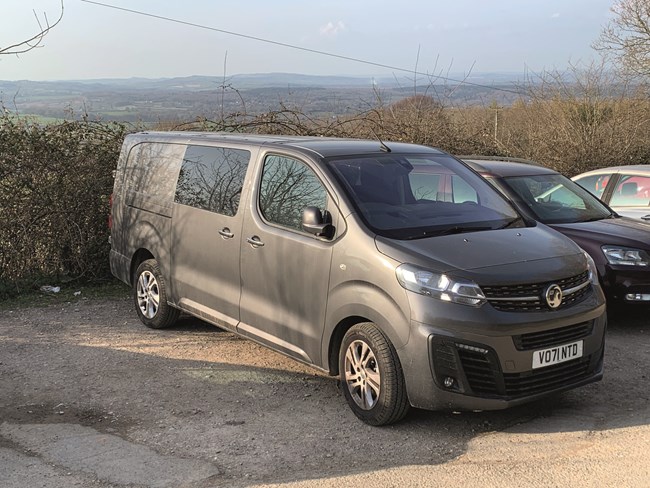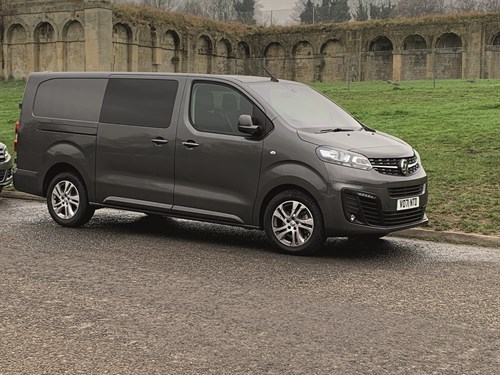- ETRUX launches new Ford E-Transit Trizone
- Renault gives UK debut to Master E-Tech at CV Show
- Isuzu D-Max long-term test – Latest Report
- Isuzu D-Max V-Cross Steel Edition revealed
- IVOTY Report: Stellantis explores the hydrogen proposition
- New Maxus EVs include eDeliver 5 van
- Used LCV values reach six-month high
- ADVERTISEMENT FEATURE: IVECO Daily Mission Awards 2024 Q2 Round-up: Grounds Maintenance & Forestry
- Stellantis Pro One electric vans review
- Mitie adds 5,000th EV to fleet
Vauxhall Vivaro long-term test – Final Report
Date: Friday, June 24, 2022 | Author: James Dallas

3rd Report
Having spent several weeks putting the Vivaro through its paces in a city setting, it was good to finally get some miles under its wheels in a variety of extra-urban environments, taking in motorways, A and B roads, country lanes and even unpaved rural tracks.
One of my concerns was whether the slightly off-centre driving position mentioned in my last report would prove to be an issue on a long journey but, thankfully, I arrived in rural Gloucestershire after several hours behind the wheel, during a drive extended by ubiquitous roadworks and a motorway junction closure, without any new and unwelcome aches and strains. This is testament to most other aspects of the cab being well designed for comfort.
The seats are firmish (a good thing) and supportive, while the gear stick is within easy reach and at a good height for the driver, although the gear knob itself is peculiarly and unnecessarily bulbous, in my opinion.
The six-way adjustable driver’s seat provides ample options to find your best driving position and a lumbar adjustment wheel and armrest (although just the one) further boost comfort when you’re spending a long time in the saddle. A padded head restraint also helps, and is a feature included for front and rear seat passengers. Those in the back get three individually contoured seats and a 12V socket but, disappointingly, these seats are not equipped with child isofix mountings.

Getting back to the driver, it goes without saying that the steering wheel is adjustable for reach and rake. This facilitates finding the most comfortable steering position. Buttons for operating audio and a smartphone – once it is paired via Bluetooth – are mounted on the steering column, as are the controls for the semi-adaptive cruise control. This not only makes for a more relaxing drive on long motorway stretches, but more importantly increases safety by using engine braking to keep a set following distance to the vehicle ahead. The system can be switched on at speeds of between 25mph and 93mph. If the selected following distance cannot be maintained because the vehicle in front is moving too slowly, a warning chime sounds and a message appears in the driver information centre, located in the dashboard, alerting the driver to take back control of the van.
Once given its head out on the open road the 150hp engine is impressively responsive with a moderate load in the back and reasonably quiet. Road and wind noise are also well suppressed in the cab and the ride quality proved to be smooth on a variety of road surfaces.
While the EAT8 automatic might be the transmission of choice for the Vivaro, the top cruising gear of the six-speed manual gearbox is well matched to long drives on faster routes, although when frequently moving up and down the cogs in traffic or on winding country roads it is adequate rather than outstanding, particularly in comparison to the likes of the Ford Transit Custom or Volkswagen Transporter. More impressive is the Vivaro’s reassuringly sharp handling when pressed hard into corners. The L2 double-cab is a fairly large van but, to its credit, it does not feel like one to drive.
Report card: Driving = 4/5
A responsive engine combines with sharp handling and decent levels of in-cab comfort.
Vauxhall Vivaro doublecab Elite 3100 L2H1 2.0 150hp
Mileage 842mls
Official combined fuel economy 31.8mpg
Our average consumption 33.1mpg
Price range (ex VAT) £24,378-£30,518
Price (ex VAT) £30,518
Warranty 3yrs/100,000mls
Service intervals 30,000mls
Load length 2,365mm
Load width (min/max) 1,258mm/1,636mm
Load bay height 1,396mm
Load volume 4.0m3
Gross payload 1,245kg
Engine size/power 1,997cc/150hp
Gearbox 6-spd manual
CO2 143g/km
View The WhatVan Digital Edition


